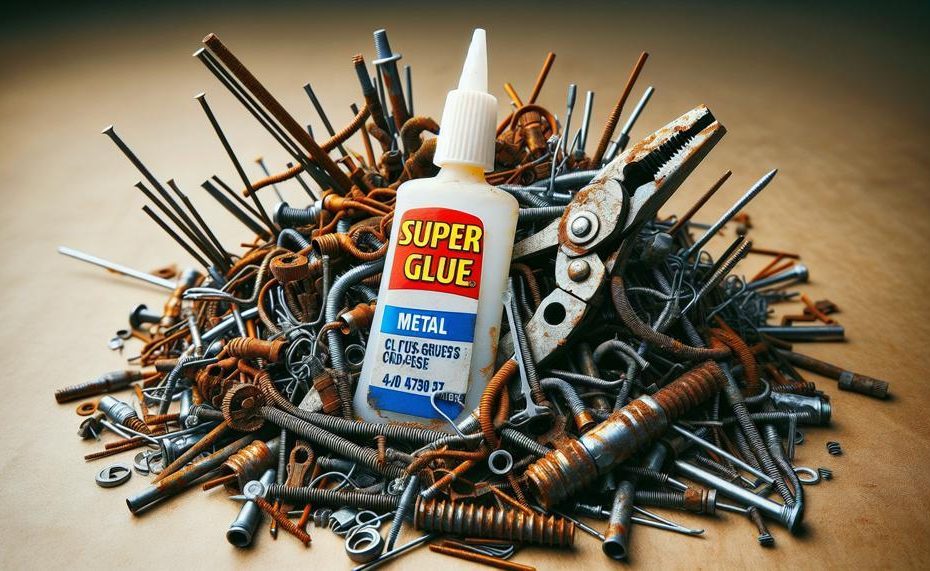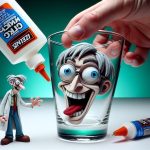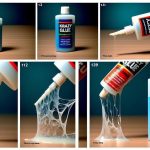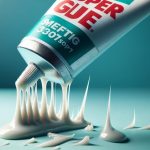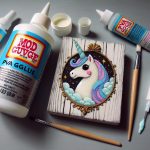Have you ever been in a sticky situation with a broken metal object? Whether it’s a cherished piece of jewelry, a household item, or even an essential car part, dealing with metal repairs can be frustrating and time-consuming.
There is one product that has proven to be the ultimate fixer-upper – krazy glue. This small but mighty adhesive has gained widespread popularity for its ability to bond almost any material together, including metal.
In this blog post, we’ll delve into the effectiveness of krazy glue on metal and why it should be a staple in your repair toolkit.
So, does krazy glue work on metal?
Yes, Krazy Glue can work on metal. Krazy Glue’s KG58548R all-purpose super glue can form a strong bond on metal, as well as wood, rubber, glass, plastic, and ceramic. Before using Krazy Glue on metal, you should clean the surface with an acetone solvent to remove oil and other residues. You should also make sure the areas you want to bond are clean and dry. Using too much glue may take longer to bond or may not bond at all.
If you’re tired of struggling with traditional methods of fixing metal objects or simply seeking a reliable solution, keep reading to discover the magic of krazy glue on metal.
Table of Contents
- 1 What is Krazy Glue?
- 2 What Types of Metals Can Krazy Glue Bond?
- 3 What Surface Preparation is Required for Using Krazy Glue on Metal?
- 4 How to Apply Krazy Glue to Metal?
- 5 Does Krazy Glue Work on All Types of Metals?
- 6 Is Krazy Glue Suitable for Load-Bearing or High-Stress Applications?
- 7 Factors to Consider When Using Krazy Glue on Metal
- 8 Alternatives to Krazy Glue for Bonding Metal
- 9 Conclusion
What is Krazy Glue?
Krazy Glue, also known as super glue, is an incredibly powerful adhesive that is widely used for quick and easy repairs on various surfaces. It is specifically designed to bond materials together, even on metal surfaces. But what makes it so effective on metals?
The main ingredient in Krazy Glue is cyanoacrylates, which form strong bonds when they come into contact with moisture in the air. When applied to a metal surface, the glue reacts with the moisture and creates a chemical reaction that causes it to harden and form an incredibly durable bond.
But it’s not just the composition of Krazy Glue that makes it so effective on metal surfaces. It also contains rubber particles that contribute to its strength and flexibility. This is crucial when bonding metal surfaces, as they can experience stress and movement. The rubber particles allow the glue to absorb shocks and prevent the bond from breaking under pressure.
In addition to its powerful composition, Krazy Glue also boasts a lightning-fast drying time of only 10-30 seconds. This sets it apart from other adhesives that may take several minutes or even hours to dry. With such a quick drying time, Krazy Glue is perfect for urgent fixes and projects where time is of the essence.
Of course, proper preparation of the metal surface is crucial for Krazy Glue to work effectively. It is essential to thoroughly clean and dry the surface before applying the glue, as any dirt, oil, or moisture can hinder the bond. Roughening or sanding the surface can also help create an even stronger bond.
What Types of Metals Can Krazy Glue Bond?
Krazy Glue is a versatile adhesive that can bond to a wide range of metals, including aluminum, steel, copper, and brass. However, the effectiveness of its bond may vary depending on the specific metal’s surface properties and composition.
To help you understand which types of metals Krazy Glue can bond to and its effectiveness, here is a breakdown:
| Metal Type | Bonding Effectiveness | Reason |
| Aluminum | Good | Krazy Glue forms a strong bond with aluminum, but it may not work well on dirty or oily surfaces due to their potential to hinder adhesion. |
| Steel | Excellent | The smooth surface of steel allows for a strong bond with Krazy Glue, making it a popular choice for metal repairs. It is also less likely to have contaminants that could affect the bond. |
| Copper | Good | Krazy Glue can bond to copper, but it may not be as strong as other metals due to its high electrical conductivity and tendency to corrode easily. |
| Brass | Fair | Krazy Glue can bond to brass, but it may not be as strong as other metals due to its low melting point and potential for tarnishing over time. |
| Other Metals (e.g. iron, nickel) | Good – Excellent | The bonding effectiveness on other metals may vary depending on their surface properties and composition. It is recommended to test a small area first before using Krazy Glue on a larger scale. |
Generally, for best results, it is important to ensure that the metal surface is smooth, clean, and dry before applying Krazy Glue. Lightly sanding the surface can help improve adhesion.
However, it is important to note that Krazy Glue may not be suitable for heavy-duty metal repairs or surfaces that will be exposed to extreme temperatures or harsh chemicals.
While Krazy Glue is a reliable option for bonding most types of metal, it is always wise to refer to the specific instructions and recommendations for the type of metal you are working with.
Some metals may require a different type of adhesive for a stronger and more permanent bond.
It is also crucial to follow safety precautions and handle Krazy Glue properly when using it on metal surfaces.
What Surface Preparation is Required for Using Krazy Glue on Metal?
Before using Krazy Glue to bond metal surfaces, proper surface preparation is crucial for achieving maximum adhesion.
This involves thoroughly cleaning and drying the surface, as well as considering the specific properties of the metal being bonded.
- Thoroughly clean the surface: The first and most important step in preparing a metal surface for Krazy Glue is to clean it thoroughly. Any dirt, dust, or grease on the surface can hinder the glue’s ability to properly bond. Use a mild soap and water to clean the surface, then dry it with a clean cloth.
- Sand or file the surface: If the metal surface is rough or uneven, sanding or filing it can greatly improve adhesion. This creates more surface area for the glue to bond to and results in a stronger overall bond.
- Consider the type of metal: Different metals have varying properties that can affect how well Krazy Glue bonds to them. For instance, smooth and non-porous metals like stainless steel may require more preparation compared to rough and porous metals like cast iron.
- Slightly dampen the surfaces: Krazy Glue is activated by moisture, so lightly dampening the surfaces before bonding can help enhance adhesion. However, be cautious not to use too much water as it can dilute the glue and affect its bonding strength.
- Apply a small amount of glue: It is essential not to use too much glue when bonding metal surfaces as it can cause the pieces to slide around and result in an improper bond. Apply a small amount of glue to one surface and hold the pieces together for 30 seconds while it sets.
- Remove excess glue: Once set, any excess glue can be filed or sanded off for a clean finish. Be careful not to disturb the bond while removing excess glue.
By following these steps, you can ensure that your metal surfaces are adequately prepared for using Krazy Glue, resulting in a robust and long-lasting bond.
How to Apply Krazy Glue to Metal?
If you want a strong and durable bond between two metal surfaces, follow these simple steps for applying Krazy Glue:
- Get the surfaces ready: Before using Krazy Glue, ensure that the metal surfaces are clean, dry, and free of any dirt, oil, or residue. This will guarantee a secure bond.
- Apply a small amount of glue: For smaller surfaces, use a pea-sized drop of glue. For larger surfaces, apply multiple drops in a zig-zag pattern.
- Press the surfaces together: Quickly and firmly press the two surfaces together. Hold them in place for at least 30 seconds to allow the glue to set.
- Use clamps or weights: If you’re working with larger or heavier metal pieces, use clamps or weights to hold the surfaces together while the glue dries.
- Give it time to dry completely: Krazy Glue dries rapidly, but make sure to wait for it to dry completely before using the bonded objects. Avoid putting any stress or pressure on the bond until the glue is fully dried.
- Clean up any extra glue: If there is any excess glue, wipe it away with a damp cloth or paper towel before it dries. If the glue has already dried, you can remove it with acetone or nail polish remover.
- Be gentle with the bond: While Krazy Glue creates a strong bond, avoid applying excessive force on bonded metal surfaces as it may weaken or break the bond.
Always read and follow the instructions on the packaging for best results. With proper application, Krazy Glue can provide a strong and long-lasting bond on metal surfaces.
Does Krazy Glue Work on All Types of Metals?
Yes, Krazy Glue’s All-Purpose Formula can bond to metal. It can also bond to other materials, including:
- Wood
- Rubber
- Glass
- Plastic
- Ceramic
- Leather
Krazy Glue’s All-Purpose Formula is strong, can hold over 1,000 pounds, and bonds in 10 seconds. It’s available in liquid and gel formulas.
For best results, Krazy Glue recommends cleaning metal with an acetone solvent before using their glue.
Is Krazy Glue Suitable for Load-Bearing or High-Stress Applications?
Krazy Glue is suitable for low load-bearing applications and filling gaps and seams. It’s also strong enough to hold over 1,000 pounds and can bond to many surfaces, including plastic, ceramic, wood, rubber, metal, and leather.
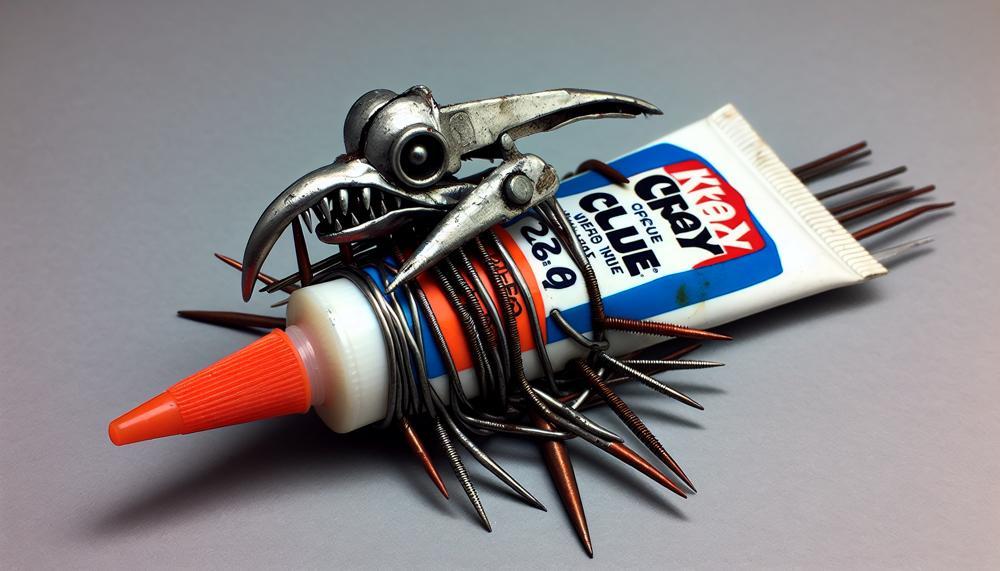
However, super glues and instant adhesives are brittle and can’t withstand strong shearing forces. They aren’t suitable for structural applications.
Factors to Consider When Using Krazy Glue on Metal
When looking to use Krazy Glue on metal, there are several important factors to keep in mind. These include the properties of the glue and metal, pressure applied during bonding, temperature and humidity control, and the intended use of the bonded object.
Each of these plays a crucial role in achieving a strong and durable bond between metal surfaces. To better understand these factors, refer to the table below:
| Factors to consider: | Importance: |
| Properties of Krazy Glue and metal | High |
| Pressure applied during bonding | High |
| Temperature and humidity control | Medium |
| Intended use of bonded object | Low |
- Properties of Krazy Glue and metal: To determine if Krazy Glue is the right adhesive for your specific needs, it is important to understand the properties of both the glue and the metal surface. For example, Krazy Glue works best on smooth surfaces and may require additional preparation when bonding with non-porous metals like stainless steel or aluminum.
- Pressure applied during bonding: It is crucial to apply firm pressure for at least 30 seconds when bonding with Krazy Glue. However, this may vary depending on the type of metal and surface area being bonded. Following the manufacturer’s instructions is key to achieving a strong bond.
- Temperature and humidity control: Extreme temperatures can greatly impact the bonding process and result in weaker bonds. To ensure a successful bond, it is important to work in an environment with optimal temperature (50-75°F/10-24°C) and humidity levels.
- Intended use of bonded object: The intended use of the bonded object is also an important factor to consider. If the object will be exposed to high levels of heat or moisture, it may be best to use a high temperature or waterproof adhesive specifically designed for those purposes.
Alternatives to Krazy Glue for Bonding Metal
When it comes to bonding metal, there are several effective alternatives to Krazy Glue that you can consider.
These include epoxy resin, welding, metal adhesives, soldering, mechanical fasteners, polyurethane adhesives, and hot melt adhesives. Each alternative has its own set of advantages and may be more suitable depending on the type of metal and intended use of the bonded object.
To make an informed decision, let’s take a closer look at each alternative and its properties.
Epoxy resin is a strong two-part adhesive that requires mixing before use. It forms a powerful bond and is resistant to water and chemicals, making it versatile for different types of metal. Welding, on the other hand, involves melting two metal surfaces together using high heat. This creates a strong bond and is commonly used in industrial settings. It can also be done at home with experience.
Metal adhesives are specialized adhesives designed specifically for bonding metal. They are easy to use and create a strong and durable bond that is suitable for various types of metal. Soldering is another option where filler metal is melted into the joint between two metal surfaces to create a strong bond. It is commonly used in electronics and plumbing but requires specialized equipment and skills.
Mechanical fasteners such as screws, nuts, bolts, and rivets are perfect for temporary bonds or disassembly. They provide a reliable bond and are easy to remove or replace when needed. Polyurethane adhesives are waterproof and heat-resistant super glue that is perfect for bonds exposed to moisture or high temperatures. It creates a strong and durable bond but takes longer to cure compared to other adhesives.
Lastly, hot melt adhesives are thermoplastic adhesives that are melted and applied onto the surfaces to be bonded. They create a strong bond and are commonly used in packaging. They are also suitable for bonding metal objects together.
Also Read: Is Hot Glue Conductive?
Conclusion
In summary, Krazy Glue has revolutionized the world of metal repairs with its powerful cyanoacrylate formula and rubber particles. This dynamic combination makes it a go-to fixer-upper for a wide range of metal objects. Its compact size and rapid drying time also make it a convenient solution for unexpected mishaps.
But, as with any adhesive, proper surface preparation is crucial for achieving optimal results. Thoroughly cleaning and drying the surfaces, considering the type of metal being bonded, and using the right amount of glue are all essential steps in ensuring a strong and long-lasting bond.
While Krazy Glue boasts impressive bonding capabilities with most metals, its effectiveness may vary depending on their unique properties. Smooth and non-porous metals like steel tend to yield better results than rough and porous ones like cast iron. It’s always wise to conduct a small test before committing to a larger repair job.
To sum up, whether you’re tired of struggling with traditional methods or simply seeking a reliable solution for your metal repairs, Krazy Glue is worth trying out. With proper preparation and application, it can provide a strong and durable bond that will save you time and frustration in any sticky situation involving broken metal objects.

